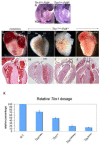Partial rescue of the Tbx1 mutant heart phenotype by Fgf8: genetic evidence of impaired tissue response to Fgf8
- PMID: 20807544
- PMCID: PMC2981862
- DOI: 10.1016/j.yjmcc.2010.08.023
Partial rescue of the Tbx1 mutant heart phenotype by Fgf8: genetic evidence of impaired tissue response to Fgf8
Abstract
Tbx1 is the candidate gene of DiGeorge syndrome and is required in humans and mice for the development of the cardiac outflow tract (OFT) and aortic arch arteries. Loss of function mutants present with reduced cell proliferation and premature differentiation of cardiac progenitor cells of the second heart field (SHF). Tbx1 regulates Fgf8 expression hence the hypothesis that the proliferation impairment may contribute to the heart phenotype of mutants. Here we show that forced Fgf8 expression modifies and partially rescues the OFT septation defects of Tbx1 mutants but only if there is some residual expression of Tbx1. This genetic experiment suggests that Tbx1, directly or indirectly, affects tissue response to Fgf8. Indeed, Tbx1(-/-) mouse embryonic fibroblasts were unable to respond to Fgf8 added to the culture media and showed defective response of Erk1/2 and Rsk1. Our data suggest a coordinated pathway modulating Fgf8 ligand expression and tissue response to it in the SHF.
Copyright © 2010 Elsevier Ltd. All rights reserved.
Figures


Similar articles
-
Fgf8 expression in the Tbx1 domain causes skeletal abnormalities and modifies the aortic arch but not the outflow tract phenotype of Tbx1 mutants.Dev Biol. 2006 Jul 15;295(2):559-70. doi: 10.1016/j.ydbio.2006.03.044. Epub 2006 Apr 4. Dev Biol. 2006. PMID: 16696966 Free PMC article.
-
Tbx1 coordinates addition of posterior second heart field progenitor cells to the arterial and venous poles of the heart.Circ Res. 2014 Oct 10;115(9):790-9. doi: 10.1161/CIRCRESAHA.115.305020. Epub 2014 Sep 4. Circ Res. 2014. PMID: 25190705
-
A genetic link between Tbx1 and fibroblast growth factor signaling.Development. 2002 Oct;129(19):4605-11. doi: 10.1242/dev.129.19.4605. Development. 2002. PMID: 12223416
-
22q11 deletion syndrome: a role for TBX1 in pharyngeal and cardiovascular development.Pediatr Cardiol. 2010 Apr;31(3):378-90. doi: 10.1007/s00246-009-9613-0. Pediatr Cardiol. 2010. PMID: 20054531 Review.
-
Tbx1, subpulmonary myocardium and conotruncal congenital heart defects.Birth Defects Res A Clin Mol Teratol. 2011 Jun;91(6):477-84. doi: 10.1002/bdra.20803. Epub 2011 May 17. Birth Defects Res A Clin Mol Teratol. 2011. PMID: 21591244 Review.
Cited by
-
Identification of a Tbx1/Tbx2/Tbx3 genetic pathway governing pharyngeal and arterial pole morphogenesis.Hum Mol Genet. 2012 Mar 15;21(6):1217-29. doi: 10.1093/hmg/ddr553. Epub 2011 Nov 24. Hum Mol Genet. 2012. PMID: 22116936 Free PMC article.
-
Understanding Heart Field Progenitor Cells for Modeling Congenital Heart Diseases.Curr Cardiol Rep. 2021 Mar 11;23(5):38. doi: 10.1007/s11886-021-01468-5. Curr Cardiol Rep. 2021. PMID: 33694131 Review.
-
The neural crest in cardiac congenital anomalies.Differentiation. 2012 Jul;84(1):25-40. doi: 10.1016/j.diff.2012.04.005. Epub 2012 May 15. Differentiation. 2012. PMID: 22595346 Free PMC article. Review.
-
A Tbx1-Six1/Eya1-Fgf8 genetic pathway controls mammalian cardiovascular and craniofacial morphogenesis.J Clin Invest. 2011 Apr;121(4):1585-95. doi: 10.1172/JCI44630. J Clin Invest. 2011. PMID: 21364285 Free PMC article.
-
Signaling in cell differentiation and morphogenesis.Cold Spring Harb Perspect Biol. 2012 Jun 1;4(6):a008151. doi: 10.1101/cshperspect.a008151. Cold Spring Harb Perspect Biol. 2012. PMID: 22570373 Free PMC article. Review.
References
-
- Prall OW, Elliott DA, Harvey RP. Developmental paradigms in heart disease: insights from tinman. Ann Med. 2002;34:148–56. - PubMed
-
- Prall OW, Menon MK, Solloway MJ, Watanabe Y, Zaffran S, Bajolle F, Biben C, McBride JJ, Robertson BR, Chaulet H, Stennard FA, Wise N, Schaft D, Wolstein O, Furtado MB, Shiratori H, Chien KR, Hamada H, Black BL, Saga Y, Robertson EJ, Buckingham ME, Harvey RP. An Nkx2-5/Bmp2/Smad1 negative feedback loop controls heart progenitor specification and proliferation. Cell. 2007;128:947–59. - PMC - PubMed
-
- Vitelli F, Taddei I, Morishima M, Meyers EN, Lindsay EA, Baldini A. A genetic link between Tbx1 and Fibroblast Growth Factor signaling. Development. 2002;129:4605–4611. - PubMed
Publication types
MeSH terms
Substances
Grants and funding
LinkOut - more resources
Full Text Sources
Other Literature Sources
Molecular Biology Databases
Miscellaneous

